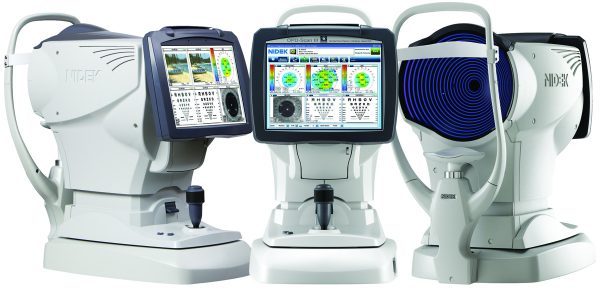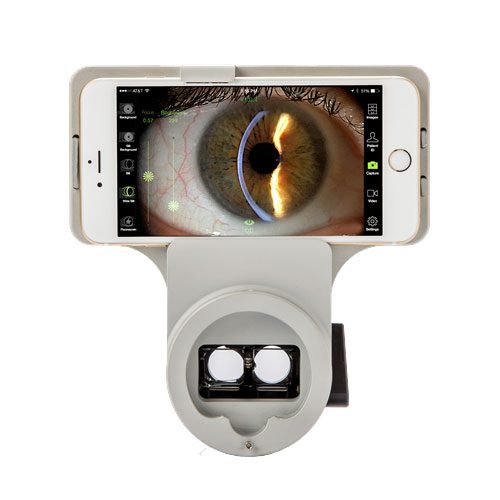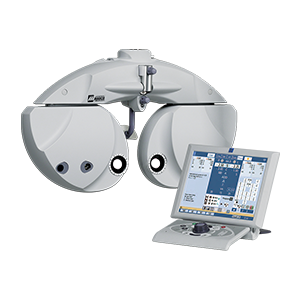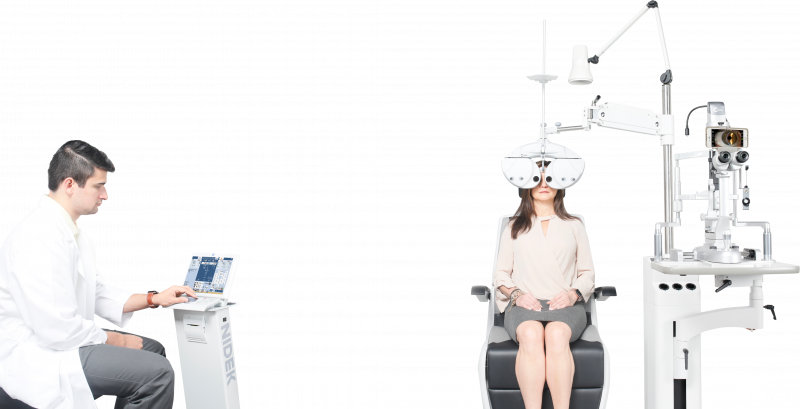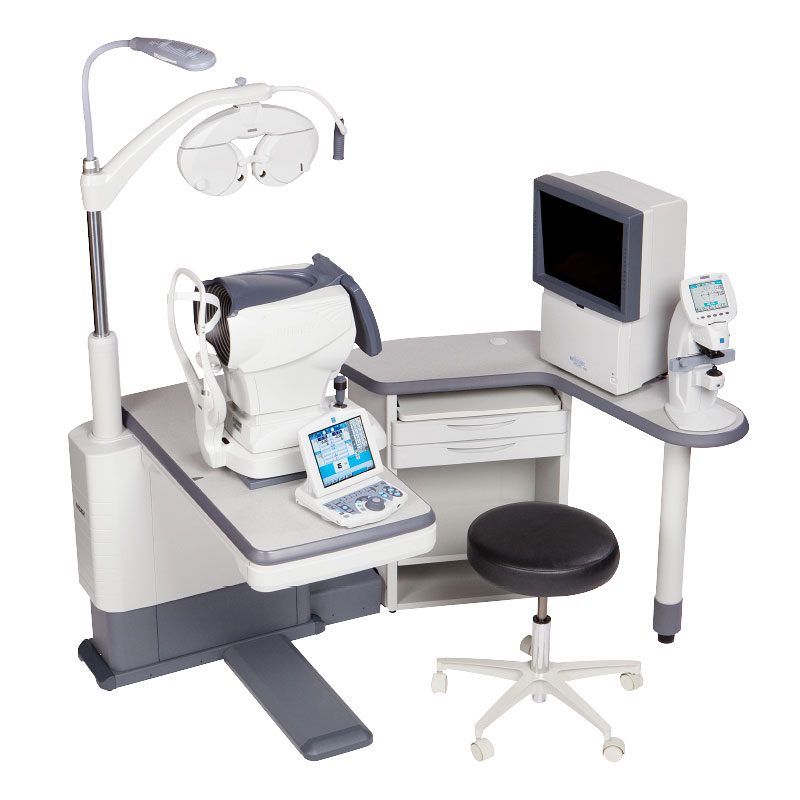Author: cvanassche
Replicate A Model That Works – An Article From Women in Optometry
Original Article Published in Women in Optometry
–
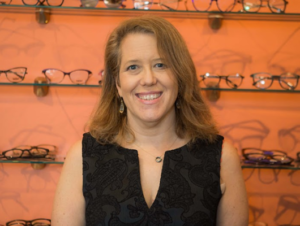 Dora Sudarsky, OD, had been considering the right time to equip a second exam room at her practice, Chroma Optics, in Burlington, Vermont. Her son will be graduating from optometry school in May 2021 and will join her in the office, so she knew the change was on the horizon. “I knew I needed to add another lane, and with COVID, I decided now was the time to do it,” Dr. Sudarsky says. She added a second TRS system from Marco as well as the ION slit lamp earlier this year, and working between two systems is allowing her to be more efficient seeing patients. She can alternate from room to room, which leaves more time for cleaning between each visitor. “It’s been awesome.”
Dora Sudarsky, OD, had been considering the right time to equip a second exam room at her practice, Chroma Optics, in Burlington, Vermont. Her son will be graduating from optometry school in May 2021 and will join her in the office, so she knew the change was on the horizon. “I knew I needed to add another lane, and with COVID, I decided now was the time to do it,” Dr. Sudarsky says. She added a second TRS system from Marco as well as the ION slit lamp earlier this year, and working between two systems is allowing her to be more efficient seeing patients. She can alternate from room to room, which leaves more time for cleaning between each visitor. “It’s been awesome.”
TECHNOLOGY IS A TOP PRIORITY
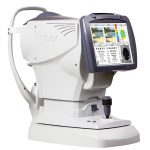
Dr. Sudarsky opened the practice in 2015, renovating and redesigning the space that was a former video store. She did most of the interior design and decorating herself to allot more of her funds to her instrumentation. Marco was on her wishlist from the start, and she opened her doors with one TRS system and the OPD III in her pretesting area. “The OPD III was above and beyond what anybody else had, and that was a big appeal,” she recalls.
Many patients followed Dr. Sudarsky from the optical where she had previously offered her optometry services, and in that space, she did not have any advanced technology. So the impression on patients has been huge and continues to be when new patients come to her office. “They tell me they’ve never seen so much technology, and while it may not all be brand-new, not every eye care practitioners embraces it the way that I have.” She recalls as she was preparing to open the practice that a colleague told her to wait and add automated refraction technology in five years. “I wanted to have it now so patients would tell their friends; that word of mouth makes a huge difference,” she says. “Some people say that they can’t afford to do it, but I say you can’t afford not to.”
BENEFITS FOR PATIENTS AND PRACTICE
Dr. Sudarsky says the staff adapted well to learning how to use the technology from Marco, and the data transfers automatically to her exam rooms so she can discuss the results with patients. “One of the things I love about the TRS system is that it’s a lot easier on my body—doctors don’t always think about that,” she says of the repetitive movement of traditional refracting. After experience her new, upgraded TRS in the second exam lane, Dr. Sudarsky is a fan of the improvements Marco has made, such as a bigger touch screen and even more intuitive software. It’s easier for her, but the experience is also simplified for patients. “Being able to press a button and show their old prescription vs. new prescription has a big impact, and I do think it has helped with upgrading and updating eyeglasses,” she adds.
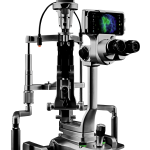 The new ION Slit lamp in her exam room has become a great patient education tool in just a few months. “I can take pictures, put them on my computer screen and share with the patients.” Dr. Sudarsky was recently recommending a switch to wear daily disposable contact lenses to a patient. “I was trying to convince her, and with the picture, I could show her that her current contact lenses were dirty, even when she said they were clean. A picture is worth a thousand words.”
The new ION Slit lamp in her exam room has become a great patient education tool in just a few months. “I can take pictures, put them on my computer screen and share with the patients.” Dr. Sudarsky was recently recommending a switch to wear daily disposable contact lenses to a patient. “I was trying to convince her, and with the picture, I could show her that her current contact lenses were dirty, even when she said they were clean. A picture is worth a thousand words.”
The OPD III has been a great asset for fitting contact lenses, and in particular, multifocal contact lenses. “It has a lot of great tools,” Dr. Sudarsky says. “I can tell if the patient’s visual axis is not the same as the center of the pupil, and I will know if multifocal contact lenses will work for them or not.” That can save her and the patient some frustration, especially compared to a system where she may have tried multiple lenses before reaching this conclusion.
Dr. Sudarsky says her efficiency has improved working with this technology, and she’s able to spend more time with each patient. “I have fewer remakes and better refractions,” she says. “I wonder how I practiced before it.”
Dr. Sudarsky didn’t know any colleagues who had technology from Marco when she took the leap, so she’s relied on the support of its team who have helped her with any question or issue that arises. She’s particularly thankful to her Marco support representative, who is a master at the OPD III and who helped Dr. Sudarsky understand how to utilize the many features and functions that the instrumentation has to offer. “They are just a text away and always willing to help,” she says.
The Marco iON Imaging System Intuitive, Optimized, and Networked
The TRS Refraction System – When You Need More Time
High-Tech Exam At A Personable But Appropriate Distance – An Article From Women in Optometry
Original Article Published in Women in Optometry
–
 When Patricia Haller, OD, added Marco technology to her Chillicothe, Ohio, practice in 2015, physical distancing was not even a thought. But when she closed her office to routine care for four weeks during the stay-home orders in the state, she realized how this same technology allowed her to see emergency and urgent cases and still maintain some distance. Dr. Haller’s practice reopened at a lighter schedule to routine eye care in early May. She discovered that Marco was a “hidden gem” in the post-COVID era.
When Patricia Haller, OD, added Marco technology to her Chillicothe, Ohio, practice in 2015, physical distancing was not even a thought. But when she closed her office to routine care for four weeks during the stay-home orders in the state, she realized how this same technology allowed her to see emergency and urgent cases and still maintain some distance. Dr. Haller’s practice reopened at a lighter schedule to routine eye care in early May. She discovered that Marco was a “hidden gem” in the post-COVID era.
REFRACTIONS AT A DISTANCE
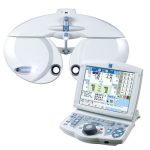 With the tabletop controller for her Marco 5100, she is able to conduct her refractions and sit about six feet away from the patients. “It’s also very easy to sterilize because all mechanisms are housed inside, so we wipe down the exterior casing without worrying,” she says.
With the tabletop controller for her Marco 5100, she is able to conduct her refractions and sit about six feet away from the patients. “It’s also very easy to sterilize because all mechanisms are housed inside, so we wipe down the exterior casing without worrying,” she says.
She already knew its value. “I purchased my first TRS in 2015 when I built the new office. I left a manual phoropter in one of my exam lanes,” she says. However, she quickly realized she didn’t want to use that room for patient exams. So now she has three units—one in each exam lane.
“It helps to keep the process streamlined. I can control the speed at which the refraction takes place,” she says—an even more important factor in the post-COVID opening. “We want patients moving through the office efficiently so that we do not have any backup in the reception area. With the TRS, it’s quick to arrive at a final refraction, and patients can see and justify their decision to buy new eyewear.”
READY TO BUY
That’s helpful because every practice is faced now with trying to make up time and lost revenue from being closed to routine care. Happily for her, she says that patients are returning, ready and eager to buy. “I was prepared for the fact that patients might not be ready to make purchases. The staff and I discussed ways in which we could help patients with their essential needs if their finances were tight,” she says. She’s not finding that to be a hindrance, however.
“They’re excited to be back and have been updating their prescription eyewear without any of the hesitation I thought that we’d see.” Dr. Haller says that it is helpful that patients can see the steps that she and the staff members are taking to keep the practice and optical clean and sanitized. “We have a UVC wand that we are using to sterilize every frame that a patient tries on before those frames are placed back on the boards. We used to wipe down our frames on a regular basis, but now they’re sterilized.”
The practice staff works on maintaining physical distancing, and opticians are masked. Patients who don’t wear a mask are offered one—and patients who would like to wait before coming in are rescheduled.
UNEXPECTED SURPRISE WITH iON
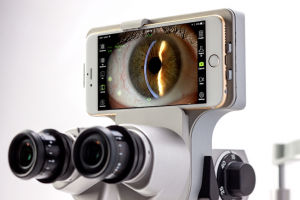
Dr. Haller added the iON imaging system to her slit lamps, allowing her to take an anterior segment image and immediately pull it up on the computer screen. She can pivot the screen toward the patient or toward an attending family member so that she can explain what she’s seeing.“I purchased the iON because I thought it would be terrific to do anterior segment documentation in the exam room where I could enhance details. The unexpected surprise is the physical distancing that I gain with this—while still providing patients with a comprehensive exam,” she says.
Dr. Haller uses Marco’s autolensmeter and autorefractor, appreciating how quickly information can be downloaded into the electronic health record. “Even before the patient is escorted to the optical, the opticians already know the lens designs and recommendations,” she says.
She knew the equipment she has been purchasing would bring her speed, accuracy and efficiency. “But the help it provides in this time is something no one could have foreseen,” she says. The combination of a high-tech, highly efficient exam process and the sanitization and safety protocols that are on display are raising the likelihood that patients are talking about the practice to their friends. “Patients are saying, ‘I had my exam there, and it’s safe to go in.’”
That feedback makes Dr. Haller happy. She says that she missed her patients. “Nothing replaces that feeling of seeing the smile on a patient’s face, knowing that you helped. It’s been challenging, as I’m a hand-shaker and hugger, but we’re managing. It’s great to see my patients back.”
[Webinar Recording] Want To Save Chair Time Fitting Lenses?
With Mayah Bowen, Director of Wavefront at Marco Ophthalmic
Topics Include:
– Wavefront Aberrometry
– Case studies
– OPD-Scan III
Request more information about Wavefront Aberrometry from Marco →
[Webinar Recording] How to Establish Safe Boundaries During a Comprehensive Exam
Brought to you by Advancing Eyecare.
Whether you’re a current Marco user or looking into the latest tools, Marco technologies can provide important patient safety measures in a post COVID-19 era.
A panel of doctors share their stories with digital refraction and slit lamp imaging that enable safe social distancing, minimize patient / doctor / staff exposure with flexible configurations, and facilitate remote exam capabilities with new software. Automated refraction offers the ability for a comprehensive, efficient, and safe exam. We also discuss software optimization to see more patients in less time, patient retention, and more.
View The Webinar ‘How to Establish Safe Boundaries During a Comprehensive Exam’:
View Marco’s Exclusive Offer →
[Webinar Recording] Cleaning and Disinfecting the Practice in the COVID-19 Era
Brought to you by Advancing Eyecare.
Reopening your practice for routine eye care involves numerous behind-the-scenes adaptations to ensure the safety and peace-of-mind of your patients, your staff, and yourself. With representation from industry-leading manufacturers, join us for an informational panel discussion to learn about cleaning, disinfection, and sterilization of your instruments and exam lanes. Every instrument has different requirements. This webinar covers what to look for in manufacturers’ instructions for use, red flags to be aware of to avoid damaging your instruments, different types of disinfecting agents, and more. Learn about sanitization of your exam lanes and instruments, myths and facts on the various types of tonometers, and what disposables and accessories are available to practice more safely.
Shop Disposables and COVID-19 Ready Accessories →
Introducing the Advancing Eyecare Webinar Series
Our team is constantly monitoring the COVID-19 situation. We conducted a survey recently and we want you to know that we’ve analyzed the results and have come up with a series of educational events based on your feedback.
Join us for one our free webinars, or register for an on-demand webinar that fits your schedule.
Click Here to see the Topics, Schedule, and Sign Up!
The Power of “Wow”
Our practice, Virginia Eye Consultants, is a tertiary care referral practice specializing in cornea, refractive, uveitis, retina, glaucoma, and oculoplastics. We firmly believe in collaborative care, and we work closely with the optometric community. Recently, our practice celebrated our 50th anniversary providing world-classspecialty eye care to our Hampton Roads community.
We house 17 providers, including 13 ophthalmologists, 4 optometrists, and 225 support team members, and we perform in excess of 5,000 surgical procedures annually, with the majority being cataract surgical procedures. We have four locations throughout the Hampton Roads area, with our main office located in Norfolk, VA, and three satellite offices located within 30 minutes of each other.
Several years ago, we made one of our best strategic and business decisions when we acquired Marco’s EPIC-5100 for our main office. This is where the majority of our providers are based and most of our cataract and refractive evaluations are performed.
The EPIC-5100 combines two of Marco’s most advanced visual pathway assessment technologies: the OPD-Scan III wavefront aberrometer and corneal analyzer and the TRS-5100 digital refractor. The two technologies can be used together to evaluate the entire visual system in a fraction of the time it takes traditional manual systems.
Indeed, we chose the EPIC-5100 system specifically to address and improve our patient throughput and efficiency, and we couldn’t be more pleased. To say the EPIC-5100 has improved our performance in this area would be an understatement. The majority of our patients are referred to us for cataract and refractive surgery from our optometric referral network. Utilizing this technology has improved our efficiency through the technician workup alone.
Prior to implementing the EPIC-5100, our technicians took nearly 40 minutes to perform a patient workup, gathering data from visual acuities to topography to refractions. In the time since we’ve acquired the EPIC-5100, we have been able to get the same amount of data in just 15 minutes, allowing us to improve both efficiency and overall time for cataract/refractive evaluations.
The user-friendly platform enables technicians to quickly gather the critical data that are used to determine each patient’s optimal treatment, whether that is for cataract or refractive surgery. A wealth of information critical to each patient’s visual system from the refraction — wavefront measurements, pupil size, angle kappa, and corneal topography — is gathered swiftly and efficiently using the EPIC-5100. The EPIC-5100, combined with the OPD-Scan III, can give us more than 20 measurements to utilize in our decision making. Even better, all of the data can be captured in about 10 seconds.
Additionally, we have an OPD-Scan III at each satellite location, which allows us to gather the clinical information necessary to make our recommendations.
Patients and Practitioners Both Benefit
The decision of whether or not to adopt new technologies can be challenging. However, when it comes to innovative technology such as the EPIC-5100, the decision was easy for us. From the “wow” factor to patient education to informed clinical decision making, patients and practitioners both benefit from the EPIC-5100 and the OPD-Scan III.
Our biggest challenge prior to adopting the EPIC-5100 was patient wait times due to bottlenecks resulting from lengthy patient workups. As in any practice, patient wait times play a significant role in the patient experience, and it is important to continuously evaluate our practice processes and procedures to optimize care. With the Marco products, we are able to utilize the technology to improve throughput as well as the staff and patient experience.
The EPIC-5100 and OPD-Scan III technology differentiate our practice and provide information we can share with our patients. It gives them the confidence that they’re in the presence of state-of-the-art technology that will be used to determine which procedures and surgeries are best for them. We measure patient satisfaction with surveys after each visit and gauge the patient experience by using the Consumer Assessment of Healthcare Providers & Systems survey; they show definitively that patients believe they’re receiving the care they need and deserve. Each survey provides different information about the experience they had and the level of satisfaction with their care.
Enhancing Patient Education and Experience
Regardless of the condition for which a patient presents, patient education is key to successful outcomes. With the OPD-Scan III, we have the ability to educate patients about the impact on the ocular surface using the placido rings from dry eye to pterygium to other corneal surface irregularities. We can use the topography maps to discuss either the normal or abnormal corneal curvature, which shows why patients may have compromised vision and what we can do to address the condition.
Another feature of the OPD-Scan III that we take advantage of to educate our patients is simulating their vision before or after correction. In a practice like ours, this is turning out to be a vital tool in helping patients recognize the benefits of a new refraction, contact lens prescription, or surgical procedure.

As an optometric referral center, our practice’s success and growth is focused on patient experience and outcomes. The “wow” factor experienced by the patient while going through testing as well as our ability to minimize wait times and the amount of time patients are seen for their cataract/refractive evaluation determines our success. The information the technology provides give us the ability to make a solid recommendation for treatment.
Marco has been a great partner with our practice in providing the support and resources we need to successfully implement and utilize their technology. From the initial training for the staff to the support for providers on how to understand and utilize the technology, Marco has truly helped us to maximize the technology in daily practice.
Innovative Technology Is Key to Success
It’s also worth noting that implementing innovative technology is a key way to help differentiate your practice, prepare it for the future, and, perhaps most importantly, protect it against competition of all kinds. Online refractions, for example, provide limited data with questionable reliability. Technologies, such as the EPIC-5100 and OPD-Scan III, however, provide an unmatched experience and information that patients simply can’t get online.
With changes in optometry due to supply and demand in eyecare providers, optometrists will be called upon to provide more medical eye care for our patients and communities. The EPIC-5100 and the OPD-Scan III can aid providers in gathering reliable data in an efficient manner while allowing us to concentrate on our patients’ medical needs, such as diabetes, glaucoma, and cataracts, something the online competition cannot do.
Optometrists would do well to recognize these benefits and respond accordingly.
– Walter Whitley, OD, MBA, FAAO, is the director of optometric services at Virginia Eye Consultants, which serves the Hampton Roads region of Virginia.


